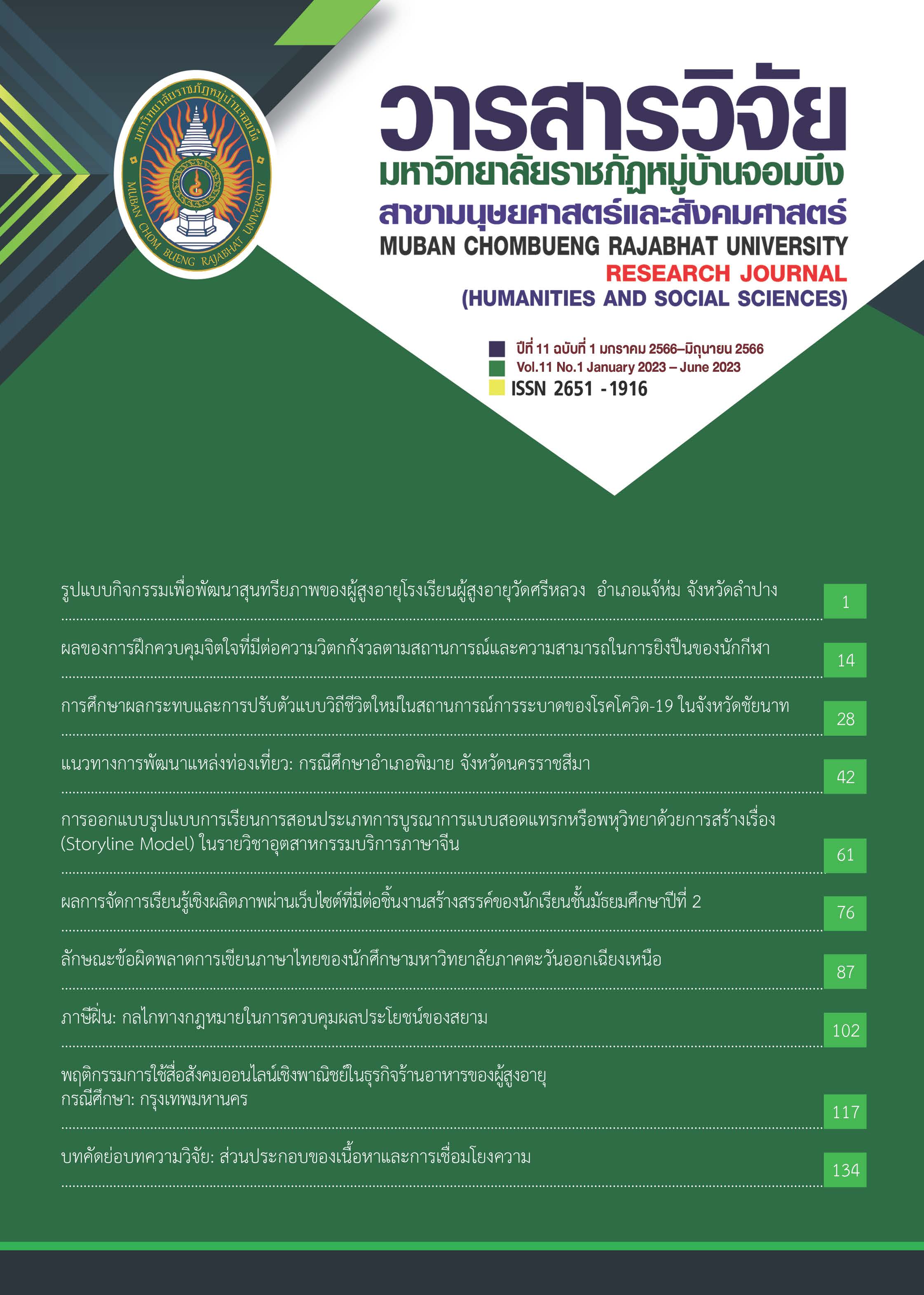ผลการจัดการเรียนรู้เชิงผลิตภาพผ่านเว็บไซต์ที่มีต่อชิ้นงานสร้างสรรค์ของนักเรียนชั้นมัธยมศึกษาปีที่ 2
คำสำคัญ:
การจัดการเรียนรู้เชิงผลิตภาพ, บทเรียนผ่านเว็บไซต์, ชิ้นงานสร้างสรรค์บทคัดย่อ
การวิจัยนี้มีวัตถุประสงค์เพื่อ 1) เปรียบเทียบผลการประเมินชิ้นงานสร้างสรรค์ ของนักเรียนชั้นมัธยมศึกษาปีที่ 2 ก่อนและหลังได้รับการจัดการเรียนรู้เชิงผลิตภาพผ่านเว็บไซต์ 2) เปรียบเทียบผลการประเมินชิ้นงานสร้างสรรค์ภายหลังได้รับการจัดการเรียนรู้เชิงผลิตภาพผ่านเว็บไซต์กับเกณฑ์ร้อยละ 70 ของคะแนนเต็ม กลุ่มตัวอย่างที่ใช้ ได้แก่ นักเรียนชั้นมัธยมศึกษาปีที่ 2 โรงเรียนองค์การบริหารส่วนตำบลบึงคำพร้อย1 (โรงเรียนวัดราษฎร์ศรัทธาราม) สังกัดกรมส่งเสริมการปกครองส่วนท้องถิ่น ภาคเรียนที่ 1 ปีการศึกษา 2564 จำนวน 30 คน โดยการสุ่มแบบหลายขั้นตอน เครื่องมือที่ใช้ คือ 1) แผนการจัดการเรียนรู้เชิงผลิตภาพผ่านเว็บไซต์ (จัดการเรียนการสอนแบบออนไลน์) จำนวน 10 แผน ใช้เวลา 20 ชั่วโมง มีความเหมาะสมในระดับมากที่สุด 2) แบบวัดชิ้นงานสร้างสรรค์ มีค่าความเชื่อมั่นเท่ากับ 0.89 3) บทเรียนผ่านเว็บไซต์ มีความเหมาะสมในระดับมากที่สุด มีค่าประสิทธิภาพตามเกณฑ์ 82.19/85.22 สถิติที่ใช้ในการวิจัย คือ ร้อยละ ค่าเฉลี่ยและส่วนเบี่ยงเบนมาตรฐาน การทดสอบค่าทีแบบกลุ่มเดี่ยว
ผลการวิจัยพบว่า 1) คะแนนประเมินชิ้นงานสร้างสรรค์ ของนักเรียนชั้นมัธยมศึกษาปีที่ 2 หลังได้รับการจัดการเรียนรู้เชิงผลิตภาพผ่านเว็บไซต์ สูงกว่าก่อนได้รับการจัดการเรียนรู้เชิงผลิตภาพผ่านเว็บไซต์ อย่างมีนัยสำคัญทางสถิติที่ระดับ 0.05 2) คะแนนประเมินชิ้นงานสร้างสรรค์ ภายหลังได้รับการจัดการเรียนรู้เชิงผลิตภาพผ่านเว็บไซต์ ของนักเรียนชั้นมัธยมศึกษาปีที่ 2 สูงกว่าเกณฑ์ ร้อยละ 70 ของคะแนนเต็ม อย่างมีนัยสำคัญทางสถิติที่ระดับ 0.05 ( = 16.97 จากคะแนนเต็ม 20 คะแนน S.D. = 1.79)
เอกสารอ้างอิง
กฤตยาณี กองอิ้ม. (2560). การพัฒนาระบบการเรียนการสอนบนเว็บตามแนวทางสะเต็มศึกษาเพื่อส่งเสริมความสามารถในการแก้ปัญหาอย่างสร้างสรรค์ สำหรับนักเรียนประถมศึกษาโรงเรียนสาธิตมหาวิทยาลัย สังกัดสำนักงานคณะกรรมการการอุดมศึกษา. วิทยานิพนธ์ดุษฎีบัณฑิต มหาวิทยาลัยมหาสารคาม.
กรมส่งเสริมการปกครองส่วนท้องถิ่น. (2564). ระบบสารสนเทศทางการศึกษาท้องถิ่น, สืบค้นเมื่อ 1 กันยายน 2564, จาก https://lec.dla.go.th.
ทิศนา แขมมณี. (2561). ศาสตร์การสอนองค์ความรู้เพื่อการจัดกระบวนการเรียนรู้ที่มีประสิทธิภาพ. กรุงเทพฯ: สำนักพิมพ์แห่งจุฬาลงกรณ์มหาวิทยาลัย.
นัสรินทร์ บือซา. (2558). ผลการจัดการเรียนรู้ตามแนวคิดสะเต็มศึกษา (STEM Education) ที่มีต่อผลสัมฤทธิ์ทางการเรียนชีววิทยา ความสามารถในการแก้ปัญหาและความพึงพอใจต่อการจัดการเรียนรู้ของนักเรียนชั้นมัธยมศึกษาปีที่ 5. วิทยานิพนธ์ศึกษาศาสตร์มหาบัณฑิต มหาวิทยาลัยสงขลานครินทร์.
ไพฑูรย์ สินลารัตน์ และคณะ. (2560). คิดผลิตภาพ : สอนและสร้างได้อย่างไร. กรุงเทพฯ: โรงพิมพ์แห่งจุฬาลงกรณ์มหาวิทยาลัย.
เลอลักษณ์ โอทกานนท์. (2561). มหาวิทยาลัย 4.0: การศึกษาเชิงผลิตภาพ. วารสารบัณฑิตศึกษา มหาวิทยาลัยราชภัฏวไลยอลงกรณ์ ในพระบรมราชูปถัมภ์. 12(3), 249-265.
วิจารณ์ พานิช. (2556). ทศวรรษเพื่อการพัฒนาระบบงานวิชาการรับใช้สังคม. วารสารการพัฒนาชุมชนและคุณภาพชีวิต. 1(1), 1-7.
สุวรรณา จุ้ยทอง. (2563). ผลการจัดกิจกรรมการเรียนรู้เชิงผลิตภาพ ที่มีต่อความสามารถในการสร้างผลงานของนักเรียนในระดับการศึกษาขั้นพื้นฐาน. วารสารวิชาการวิทยาลัยแสงธรรม. 12(1), 211-227.
ดาวน์โหลด
เผยแพร่แล้ว
รูปแบบการอ้างอิง
ฉบับ
ประเภทบทความ
สัญญาอนุญาต
ลิขสิทธิ์ (c) 2023 วารสารวิจัยมหาวิทยาลัยราชภัฏหมู่บ้านจอมบึง สาขามนุษยศาสตร์และสังคมศาสตร์

อนุญาตภายใต้เงื่อนไข Creative Commons Attribution-NonCommercial-NoDerivatives 4.0 International License.
วารสาร TCI อยู่ภายใต้การอนุญาต Creative Commons Attribution-NonCommercial-NoDerivatives 4.0 International (CC BY-NC-ND 4.0) เว้นแต่จะรุบุไว้เป็นอย่างอื่นโปรดอ่านหน้านโยบายของเราสำหรับข้อมูลเพิ่มเติมเกี่ยวกับการเช้าถึงแบบเปิด ลิขสิทธิ์ และการอนุญาต



